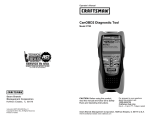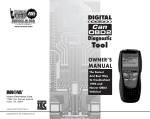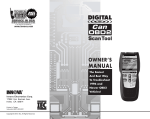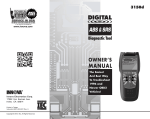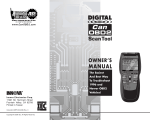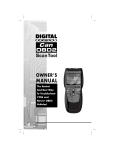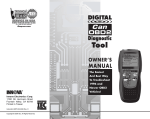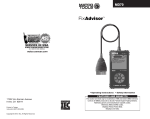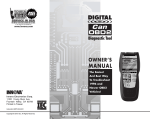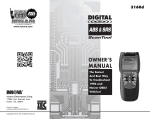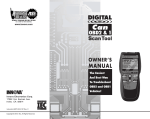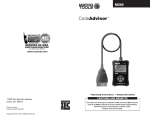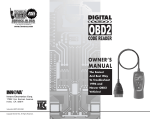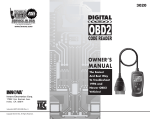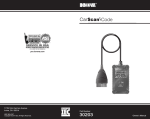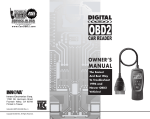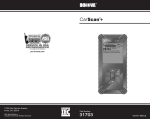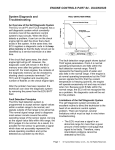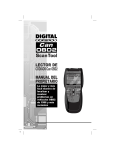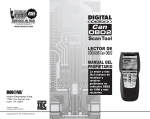Download Untitled
Transcript
® Innova Electronics Corp. 11231 Young River Ave. Fountain Valley, CA 92708 Printed in China Instruction MRP #93-0257 Copyright © 2010 IEC. All Rights Reserved. © 2010 Table of Contents i YOU CAN DO IT! .............................................................................. 1 SAFETY PRECAUTIONS SAFETY FIRST! ....................................................................... 2 ABOUT THE SCAN TOOL VEHICLES COVERED ............................................................. CONTROLS AND INDICATORS .............................................. DISPLAY FUNCTIONS ............................................................ 3 4 5 ONBOARD DIAGNOSTICS COMPUTER ENGINE CONTROLS ......................................... DIAGNOSTIC TROUBLE CODES (DTCs) .............................. OBD2 MONITORS ................................................................... 7 12 15 PREPARATION FOR TESTING BEFORE YOU BEGIN .............................................................. VEHICLE SERVICE MANUALS ............................................... 24 24 USING THE SCAN TOOL CODE RETRIEVAL PROCEDURE .......................................... ERASING DIAGNOSTIC TROUBLE CODES (DTCs) ............. 25 30 LIVE DATA MODE VIEWING LIVE DATA .............................................................. CUSTOMIZING LIVE DATA (PIDs) ......................................... 32 33 ADDITIONAL FUNCTIONS VIEWING VEHICLE INFORMATION ....................................... O2 SENSOR TEST .................................................................. ADJUSTMENTS AND SETTINGS ........................................... 35 37 38 GENERIC (GLOBAL) OBD2 PID LIST ............................................ 41 WARRANTY AND SERVICING LIMITED ONE YEAR WARRANTY .......................................... SERVICE PROCEDURES ....................................................... 49 49 OBD2 You Can Do It! EASY TO USE - EASY TO VIEW - EASY TO DEFINE Easy To Use . . . . Connect the Scan Tool to the vehicle’s test connector. Turn the ignition key "On.” DO NOT start the engine. The Scan Tool will automatically link to the vehicle’s computer. Easy To View . . . . The Scan Tool retrieves stored codes, Freeze Frame data I/M Readiness status. Codes, I/M Readiness status and Freeze Frame data are displayed on the Scan Tool’s display screen. System status is indicated by LED indicators. Easy To Define . . . . Read code definitions from the Scan Tool’s display View Freeze Frame data. View Live Data. OBD2 1 Safety Precautions SAFETY FIRST SAFETY FIRST! This manual describes common test procedures used by experienced service technicians. Many test procedures require precautions to avoid accidents that can result in personal injury, and/or damage to your vehicle or test equipment. Always read your vehicle's service manual and follow its safety precautions before and during any test or service procedure. ALWAYS observe the following general safety precautions: When an engine is running, it produces carbon monoxide, a toxic and poisonous gas. To prevent serious injury or death from carbon monoxide poisoning, operate the vehicle ONLY in a well-ventilated area. To protect your eyes from propelled objects as well as hot or caustic liquids, always wear approved safety eye protection. When an engine is running, many parts (such as the coolant fan, pulleys, fan belt etc.) turn at high speed. To avoid serious injury, always be aware of moving parts. Keep a safe distance from these parts as well as other potentially moving objects. Engine parts become very hot when the engine is running. To prevent severe burns, avoid contact with hot engine parts. P RND L Before starting an engine for testing or trouble-shooting, make sure the parking brake is engaged. Put the transmission in park (for automatic transmission) or neutral (for manual transmission). Block the drive wheels with suitable blocks. Connecting or disconnecting test equipment when the ignition is ON can damage test equipment and the vehicle's electronic components. Turn the ignition OFF before connecting the Code Reader to or disconnecting the Code Reader from the vehicle’s Data Link Connector (DLC). To prevent damage to the on-board computer when taking vehicle electrical measurements, always use a digital multimeter with at least 10 megOhms of impedance. The vehicle's battery produces highly flammable hydrogen gas. To prevent an explosion, keep all sparks, heated items and open flames away from the battery. Don't wear loose clothing or jewelry when working on an engine. Loose clothing can become caught in the fan, pulleys, belts, etc. Jewelry is highly conductive, and can cause a severe burn if it makes contact between a power source and ground. 2 OBD2 About the Scan Tool VEHICLES COVERED VEHICLES COVERED The Scan Tool is designed to work on all OBD2 compliant vehicles. All 1996 and newer vehicles (cars and light trucks) sold in the United States are OBD2 compliant. This includes all Domestic, Asian and European vehicles. Some 1994 and 1995 vehicles are OBD2 compliant. To find out if a 1994 or 1995 vehicle is OBD2 compliant, check the following: 1. The Vehicle Emissions Control Information (VECI) Label. This label is located under the hood or by the radiator of most vehicles. If the vehicle is OBD2 compliant, the label will state “OBD II Certified.” VEHICLE EMISSION CONTROL INFORMATION ENGINE FAMILY DISPLACEMENT VEHICLE MANUFACTURER EFN2.6YBT2BA 2.6L OBD II CERTIFIED THIS VEHICLE CONFORMS TO U.S. EPA AND STATE OF CALIFORNIA REGULATIONS APPLICABLE TO 1999 MODEL YEAR NEW TLEV PASSENGER CARS. REFER TO SERVICE MANUAL FOR ADDITIONAL INFORMATION TUNE-UP CONDITIONS: NORMAL OPERATING ENGINE TEMPERATURE, ACCESSORIES OFF, COOLING FAN OFF, TRANSMISSION IN NEUTRAL EXHAUST EMISSIONS STANDARDS CERTIFICATION IN-USE SPARK PLUG TYPE NGK BPRE-11 GAP: 1.1MM OBD II CERTIFIED STANDARD CATEGORY TLEV TLEV INTERMEDIATE CATALYST 2. Government Regulations require that all OBD2 compliant vehicles must have a “common” sixteen-pin Data Link Connector (DLC). 1 2 3 4 5 6 7 8 9 10111213141516 Some 1994 and 1995 vehicles have 16-pin connectors but are not OBD2 compliant. Only those vehicles with a Vehicle Emissions Control Label stating “OBD II Certified” are OBD2 compliant. Data Link Connector (DLC) Location The 16-pin DLC is usually located under the instrument panel (dash), within 12 inches (300 mm) of center of the panel, on the driver’s side of most vehicles. It should be easily accessible and visible from a kneeling position outside the vehicle with the door open. LEFT CORNER OF DASH NEAR CENTER OF DASH BEHIND ASHTRAY On some Asian and European vehicles the DLC is located behind the “ashtray” (the ashtray must be removed to access it) or on the far left corner of the dash. If the DLC cannot be located, consult the vehicle’s service manual for the location. OBD2 3 About the Scan Tool CONTROLS AND INDICATORS CONTROLS AND INDICATORS 8 5 7 9 6 1 2 4 3 Figure 1. Controls and Indicators See Figure 1 for the locations of items 1 through 9, below. 4 1. ERASE button - Erases Diagnostic Trouble Codes (DTCs) and "Freeze Frame" data from your vehicle's computer, and resets Monitor status. 2. DTC/FF button - Displays the DTC View screen and/or scrolls the display to view DTCs and Freeze Frame data when more than one DTC is present. 3. DOWN button - When in MENU mode, scrolls down through the menu and submenu selection options. When LINKED to a vehicle, scrolls down through the current display screen to display any additional data. 4. LD/ENTER button - When in MENU mode, confirms the selected option or value. When linked to a vehicle, places the Scan tool in “Live Data” mode. OBD2 About the Scan Tool DISPLAY FUNCTIONS 5. GREEN LED - Indicates that all engine systems are running normally (all Monitors on the vehicle are active and performing their diagnostic testing, and no DTCs are present). 6. YELLOW LED - Indicates there is a possible problem. A “Pending” DTC is present and/or some of the vehicle's emission monitors have not run their diagnostic testing. 7. RED LED - Indicates there is a problem in one or more of the vehicle's systems. The red LED is also used to show that DTC(s) are present. DTCs are shown on the Scan Tool’s LCD display. In this case, the Multifunction Indicator (“Check Engine”) lamp on the vehicle's instrument panel will light steady on. 8. LCD Display - Displays test results, Scan Tool functions and Monitor status information. See DISPLAY FUNCTIONS, below, for details. 9. CABLE - Connects the Scan Tool to the vehicle's Data Link Connector (DLC). DISPLAY FUNCTIONS 11 7 5 6 1 2 3 9 10 8 4 Figure 2. Display Functions See Figure 2 for the locations of items 1 through 11, below. 1. Vehicle icon - Indicates whether or not the Scan Tool is being properly powered through the vehicle's Data Link Connector (DLC). A visible icon indicates that the Scan Tool is being powered through the vehicle's DLC connector. 2. Link icon - Indicates whether or not the Scan Tool is communicating (linked) with the vehicle's on-board computer. When visible, the Scan Tool is communicating with the computer. If the Link icon is not visible, the Scan Tool is not communicating with the computer. 3. Computer icon - When this icon is visible it indicates that the Scan Tool is linked to a personal computer. Optional “PC Link” software is available that makes it possible to upload retrieved data to a personal computer. OBD2 5 About the Scan Tool DISPLAY FUNCTIONS 4. DTC Display Area - Displays the Diagnostic Trouble Code (DTC) number and definition. Each fault is assigned a code number that is specific to that fault. 5. MIL icon - Indicates the status of the Malfunction Indicator Lamp (MIL). The MIL icon is visible only when a DTC has commanded the MIL on the vehicle's dashboard to light. 6. Pending icon - Indicates the currently displayed DTC is a "Pending" code. 7. PERMANENT icon - Indicates the currently displayed DTC is a “Permanent” code. 8. FREEZE FRAME icon - Indicates that “Freeze Frame” data has been stored in the vehicle’s computer for the currently displayed DTC. 9. Code Number Sequence - The Scan Tool assigns a sequence number to each DTC that is present in the computer's memory, starting with "01.” This helps keep track of the number of DTCs present in the computer's memory. Code number "01" is always the highest priority code, and the one for which "Freeze Frame" data has been stored. 10. Code Enumerator - Indicates the total number of codes retrieved from the vehicle’s computer. 11. Monitor icons - Indicates which Monitors are supported by the vehicle under test, and whether or not the associated Monitor has run its diagnostic testing (Monitor status). When a Monitor icon is solid, it indicates that the associated Monitor has completed its diagnostic testing. When a Monitor icon is flashing, it indicates that the vehicle supports the associated Monitor, but the Monitor has not yet run its diagnostic testing. The I/M Monitor Status icons are associated with INSPECTION and MAINTENANCE (I/M) READINESS STATUS. Some states require that all vehicle Monitors have run and completed their diagnostic testing before a vehicle can be tested for Emissions (Smog Check). A maximum of fifteen Monitors are used on OBD2 systems. Not all vehicles support all fifteen Monitors. When the Scan Tool is linked to a vehicle, only the icons for Monitors that are supported by the vehicle under test are visible on the display. 6 OBD2 Onboard Diagnostics COMPUTER ENGINE CONTROLS COMPUTER ENGINE CONTROLS The Introduction of Electronic Engine Controls Electronic Computer Control Systems make it possible for vehicle manufacturers to comply with the tougher emissions and fuel efficiency standards mandated by State and Federal Governments. As a result of increased air pollution (smog) in large cities, such as Los Angeles, the California Air Resources Board (CARB) and the Environmental Protection Agency (EPA) set new regulations and air pollution standards to deal with the problem. To further complicate matters, the energy crisis of the early 1970s caused a sharp increase in fuel prices over a short period. As a result, vehicle manufacturers were not only required to comply with the new emissions standards, they also had to make their vehicles more fuel-efficient. Most vehicles were required to meet a miles-per-gallon (MPG) standard set by the U.S. Federal Government. Precise fuel delivery and spark timing are needed to reduce vehicle emissions. Mechanical engine controls in use at the time (such as ignition points, mechanical spark advance and the carburetor) responded too slowly to driving conditions to properly control fuel delivery and spark timing. This made it difficult for vehicle manufacturers to meet the new standards. A new Engine Control System had to be designed and integrated with the engine controls to meet the stricter standards. The new system had to: Respond instantly to supply the proper mixture of air and fuel for any driving condition (idle, cruising, low-speed driving, high-speed driving, etc.). Calculate instantly the best time to “ignite” the air/fuel mixture for maximum engine efficiency. Perform both these tasks without affecting vehicle performance or fuel economy. Vehicle Computer Control Systems can perform millions of calculations each second. This makes them an ideal substitute for the slower mechanical engine controls. By switching from mechanical to electronic engine controls, vehicle manufacturers are able to control fuel delivery and spark timing more precisely. Some newer Computer Control Systems also provide control over other vehicle functions, such as transmission, brakes, charging, body, and suspension systems. OBD2 7 Onboard Diagnostics COMPUTER ENGINE CONTROLS The Basic Engine Computer Control System The Computer Control System consists of an on-board computer and several related control devices (sensors, switches, and actuators). The on-board computer is the heart of the Computer Control System. The computer contains several programs with preset reference values for air/fuel ratio, spark or ignition timing, injector pulse width, engine speed, etc. Separate values are provided for various driving conditions, such as idle, low speed driving, high-speed driving, low load, or high load. The preset reference values represent the ideal air/fuel mixture, spark timing, transmission gear selection, etc., for any driving condition. These values are programmed by the vehicle manufacturer, and are specific to each vehicle model. Most on-board computers are located inside the vehicle behind the dashboard, under the passenger’s or driver’s seat, or behind the right kick panel. However, some manufacturers may still position it in the engine compartment. Vehicle sensors, switches, and actuators are located throughout the engine, and are connected by electrical wiring to the on-board computer. These devices include oxygen sensors, coolant temperature sensors, throttle position sensors, fuel injectors, etc. Sensors and switches are input devices. They provide signals representing current engine operating conditions to the computer. Actuators are output devices. They perform actions in response to commands received from the computer. The on-board computer receives information inputs from sensors and switches located throughout the engine. These devices monitor critical engine conditions such as coolant temperature, engine speed, engine load, throttle position, air/fuel ratio etc. The computer compares the values received from these sensors with its preset reference values, and makes corrective actions as needed so that the sensor values always match the preset reference values for the current driving condition. The computer makes adjustments by commanding other devices such as the fuel injectors, idle air control, EGR valve or Ignition Module to perform these actions. TYPICAL COMPUTER CONTROL SYSTEM OUTPUT DEVICES Fuel Injectors Idle Air Control EGR Valve Ignition Module On-Board Computer INPUT DEVICES Coolant Temperature Sensor Throttle Position Sensor Fuel Injectors 8 INPUT DEVICES Oxygen Sensors OBD2 Onboard Diagnostics COMPUTER ENGINE CONTROLS Vehicle operating conditions are constantly changing. The computer continuously makes adjustments or corrections (especially to the air/fuel mixture and spark timing) to keep all the engine systems operating within the preset reference values. On-Board Diagnostics - First Generation (OBD1) With the exception of some 1994 and 1995 vehicles, most vehicles from 1982 to 1995 are equipped with some type of first generation On-Board Diagnostics. Beginning in 1988, California’s Air Resources Board (CARB), and later the Environmental Protection Agency (EPA) required vehicle manufacturers to include a self-diagnostic program in their on-board computers. The program would be capable of identifying emissions-related faults in a system. The first generation of Onboard Diagnostics came to be known as OBD1. OBD1 is a set of self-testing and diagnostic instructions programmed into the vehicle’s on-board computer. The programs are specifically designed to detect failures in the sensors, actuators, switches and wiring of the various vehicle emissions-related systems. If the computer detects a failure in any of these components or systems, it lights an indicator on the dashboard to alert the driver. The indicator lights only when an emissions-related problem is detected. The computer also assigns a numeric code for each specific problem that it detects, and stores these codes in its memory for later retrieval. These codes can be retrieved from the computer’s memory with the use of a “Code Reader” or a “Scan Tool.” On-Board Diagnostics - Second Generation (OBD2) In addition to performing all the functions of the OBD1 System, the The OBD2 System is OBD2 System has been enhanced with an enhancement of the new Diagnostic Programs. These OBD1 System. programs closely monitor the functions of various emissions-related components and systems (as well as other systems) and make this information readily available (with the proper equipment) to the technician for evaluation. The California Air Resources Board (CARB) conducted studies on OBD1 equipped vehicles. The information that was gathered from these studies showed the following: OBD2 A large number of vehicles had deteriorating or degraded emissions-related components. These components were causing an increase in emissions. 9 Onboard Diagnostics COMPUTER ENGINE CONTROLS Because OBD1 systems only detect failed components, the degraded components were not setting codes. Some emissions problems related to degraded components only occur when the vehicle is being driven under a load. The emission checks being conducted at the time were not performed under simulated driving conditions. As a result, a significant number of vehicles with degraded components were passing Emissions Tests. Codes, code definitions, diagnostic connectors, communication protocols and emissions terminology were different for each manufacturer. This caused confusion for the technicians working on different make and model vehicles. To address the problems made evident by this study, CARB and the EPA passed new laws and standardization requirements. These laws required that vehicle manufacturers to equip their new vehicles with devices capable of meeting all of the new emissions standards and regulations. It was also decided that an enhanced on-board diagnostic system, capable of addressing all of these problems, was needed. This new system is known as “On-Board Diagnostics Generation Two (OBD2).” The primary objective of the OBD2 system is to comply with the latest regulations and emissions standards established by CARB and the EPA. The Main Objectives of the OBD2 System are: To detect degraded and/or failed emissions-related components or systems that could cause tailpipe emissions to exceed by 1.5 times the Federal Test Procedure (FTP) standard. To expand emissions-related system monitoring. This includes a set of computer run diagnostics called Monitors. Monitors perform diagnostics and testing to verify that all emissions-related components and/or systems are operating correctly and within the manufacturer’s specifications. To use a standardized Diagnostic Link Connector (DLC) in all vehicles. (Before OBD2, DLCs were of different shapes and sizes.) To standardize the code numbers, code definitions and language used to describe faults. (Before OBD2, each vehicle manufacturer used their own code numbers, code definitions and language to describe the same faults.) To expand the operation of the Malfunction Indicator Lamp (MIL). To standardize communication procedures and protocols between the diagnostic equipment (Scan Tools, Code Readers, etc.) and the vehicle’s on-board computer. OBD2 Terminology The following terms and their definitions are related to OBD2 systems. Read and reference this list as needed to aid in the understanding of OBD2 systems. 10 OBD2 Onboard Diagnostics COMPUTER ENGINE CONTROLS Powertrain Control Module (PCM) - The PCM is the OBD2 accepted term for the vehicle’s “on-board computer.” In addition to controlling the engine management and emissions systems, the PCM also participates in controlling the powertrain (transmission) operation. Most PCMs also have the ability to communicate with other computers on the vehicle (ABS, ride control, body, etc.). Monitor - Monitors are “diagnostic routines” programmed into the PCM. The PCM utilizes these programs to run diagnostic tests, and to monitor operation of the vehicle’s emissions-related components or systems to ensure they are operating correctly and within the vehicle’s manufacturer specifications. Currently, up to eleven Monitors are used in OBD2 systems. Additional Monitors will be added as the OBD2 system is further developed. Not all vehicles support all eleven Monitors. Enabling Criteria - Each Monitor is designed to test and monitor the operation of a specific part of the vehicle’s emissions system (EGR system, oxygen sensor, catalytic converter, etc.). A specific set of “conditions” or “driving procedures” must be met before the computer can command a Monitor to run tests on its related system. These “conditions” are known as “Enabling Criteria.” The requirements and procedures vary for each Monitor. Some Monitors only require the ignition key to be turned “On” for them to run and complete their diagnostic testing. Others may require a set of complex procedures, such as, starting the vehicle when cold, bringing it to operating temperature, and driving the vehicle under specific conditions before the Monitor can run and complete its diagnostic testing. Monitor Has/Has Not Run - The terms “Monitor has run” or “Monitor has not run” are used throughout this manual. “Monitor has run,” means the PCM has commanded a particular Monitor to perform the required diagnostic testing on a system to ensure the system is operating correctly (within factory specifications). The term “Monitor has not run” means the PCM has not yet commanded a particular Monitor to perform diagnostic testing on its associated part of the emissions system. Trip - A Trip for a particular Monitor requires that the vehicle is being driven in such a way that all the required “Enabling Criteria” for the Monitor to run and complete its diagnostic testing are met. The “Trip Drive Cycle” for a particular Monitor begins when the ignition key is turned “On.” It is successfully completed when all the “Enabling Criteria” for the Monitor to run and complete its diagnostic testing are met by the time the ignition key is turned “Off.” Since each of the eleven monitors is designed to run diagnostics and testing on a different part of the engine or emissions system, the “Trip Drive Cycle” needed for each individual Monitor to run and complete varies. OBD2 11 Onboard Diagnostics DIAGNOSTIC TROUBLE CODES (DTCs) OBD2 Drive Cycle - An OBD2 Drive Cycle is an extended set of driving procedures that takes into consideration the various types of driving conditions encountered in real life. These conditions may include starting the vehicle when it is cold, driving the vehicle at a steady speed (cruising), accelerating, etc. An OBD2 Drive Cycle begins when the ignition key is turned “On” (when cold) and ends when the vehicle has been driven in such a way as to have all the “Enabling Criteria” met for all its applicable Monitors. Only those trips that provide the Enabling Criteria for all Monitors applicable to the vehicle to run and complete their individual diagnostic tests qualify as an OBD2 Drive Cycle. OBD2 Drive Cycle requirements vary from one model of vehicle to another. Vehicle manufacturers set these procedures. Consult your vehicle’s service manual for OBD2 Drive Cycle procedures. Do not confuse a “Trip” Drive Cycle with an OBD2 Drive Cycle. A “Trip” Drive Cycle provides the “Enabling Criteria” for one specific Monitor to run and complete its diagnostic testing. An OBD2 Drive Cycle must meet the “Enabling Criteria” for all Monitors on a particular vehicle to run and complete their diagnostic testing. Warm-up Cycle - Vehicle operation after an engine off period where engine temperature rises at least 40°F (22°C) from its temperature before starting, and reaches at least 160°F (70°C). The PCM uses warm-up cycles as a counter to automatically erase a specific code and related data from its memory. When no faults related to the original problem are detected within a specified number of warm-up cycles, the code is erased automatically. DIAGNOSTIC TROUBLE CODES (DTCs) Diagnostic Trouble Codes (DTCs) are Diagnostic Trouble meant to guide you to the proper service procedure in the vehicle’s Codes (DTCs) are service manual. DO NOT replace parts codes that identify a based only on DTCs without first specific problem area. consulting the vehicle’s service manual for proper testing procedures for that particular system, circuit or component. DTCs are alphanumeric codes that are used to identify a problem that is present in any of the systems that are monitored by the on-board computer (PCM). Each trouble code has an assigned message that identifies the circuit, component or system area where the problem was found. OBD2 diagnostic trouble codes are made up of five characters: 12 The 1st character is a letter. It identifies the “main system” where the fault occurred (Body, Chassis, Powertrain, or Network). The 2nd character is a numeric digit. It identifies the “type” of code (Generic or Manufacturer-Specific). OBD2 Onboard Diagnostics DIAGNOSTIC TROUBLE CODES (DTCs) Generic DTCs are codes that are used by all vehicle manufacturers. The standards for generic DTCs, as well as their definitions, are set by the Society of Automotive Engineers (SAE). Manufacturer-Specific DTCs are codes that are controlled by the vehicle manufacturers. The Federal Government does not require vehicle manufacturers to go beyond the standardized generic DTCs in order to comply with the new OBD2 emissions standards. However, manufacturers are free to expand beyond the standardized codes to make their systems easier to diagnose. The 3rd character is a numeric digit. It identifies the specific system or sub-system where the problem is located. The 4th and 5th characters are numeric digits. They identify the section of the system that is malfunctioning. OBD2 DTC EXAMPLE P0201 - Injector Circuit Malfunction, Cylinder 1 B C P U - Body Chassis Powertrain Network 0 1 2 3 - Generic Manufacturer Specific Generic Includes both Generic and Manufacturer Specific Codes P0201 Identifies the system where the problem is located: 1 - Fuel and Air Metering 2 - Fuel and Air Metering (injector circuit malfunction only) 3 - Ignition System or Misfire 4 - Auxiliary Emission Control System 5 - Vehicle Speed Control and Idle Control System 6 - Computer Output Circuits 7 - Transmission 8 - Transmission Identifies what section of the system is malfunctioning OBD2 13 Onboard Diagnostics DIAGNOSTIC TROUBLE CODES (DTCs) DTCs and MIL Status When the vehicle’s on-board computer detects a failure in an emissions-related component or system, the computer’s internal diagnostic program assigns a diagnostic trouble code (DTC) that points to the system (and subsystem) where the fault was found. The diagnostic program saves the code in the computer’s memory. It records a “Freeze Frame” of conditions present when the fault was found, and lights the Malfunction Indicator Lamp (MIL). Some faults require detection for two trips in a row before the MIL is turned on. The “Malfunction Indicator Lamp” (MIL) is the accepted term used to describe the lamp on the dashboard that lights to warn the driver that an emissions-related fault has been found. Some manufacturers may still call this lamp a “Check Engine” or “Service Engine Soon” light. There are two types of DTCs used for emissions-related faults: Type “A” and Type “B.” Type “A” codes are “One-Trip” codes; Type “B” DTCs are usually Two-Trip DTCs. When a Type “A” DTC is found on the First Trip, the following events take place: The computer commands the MIL “On” when the failure is first found. If the failure causes a severe misfire that may cause damage to the catalytic converter, the MIL “flashes” once per second. The MIL continues to flash as long as the condition exists. If the condition that caused the MIL to flash is no longer present, the MIL will light “steady” On. A DTC is saved in the computer’s memory for later retrieval. A “Freeze Frame” of the conditions present in the engine or emissions system when the MIL was ordered “On” is saved in the computer’s memory for later retrieval. This information shows fuel system status (closed loop or open loop), engine load, coolant temperature, fuel trim value, MAP vacuum, engine RPM and DTC priority. When a Type “B” DTC is found on the First Trip, the following events take place: The computer sets a Pending DTC, but the MIL is not ordered “On.” “Freeze Frame” data may or may not be saved at this time depending on manufacturer. The Pending DTC is saved in the computer’s memory for later retrieval. If the failure is found on the second consecutive trip, the MIL is ordered “On.” “Freeze Frame” data is saved in the computer’s memory. If the failure is not found on the second Trip, the Pending DTC is erased from the computer’s memory. The MIL will stay lit for both Type “A” and Type “B” codes until one of the following conditions occurs: 14 OBD2 Onboard Diagnostics OBD2 MONITORS If the conditions that caused the MIL to light are no longer present for the next three trips in a row, the computer automatically turns the MIL “Off” if no other emissions-related faults are present. However, the DTCs remain in the computer’s memory as a history code for 40 warm-up cycles (80 warm-up cycles for fuel and misfire faults). The DTCs are automatically erased if the fault that caused them to be set is not detected again during that period. Misfire and fuel system faults require three trips with “similar conditions” before the MIL is turned “Off.” These are trips where the engine load, RPM and temperature are similar to the conditions present when the fault was first found. After the MIL has been turned off, DTCs and Freeze Frame data stay in the computer’s memory. Erasing the DTCs from the computer’s memory can also turn off the MIL. See ERASING DIAGNOSTIC TROUBLE CODES (DTCs) on page 30, before erasing codes from the computer’s memory. If a Diagnostic Tool or Scan Tool is used to erase the codes, Freeze Frame data will also be erased. OBD2 MONITORS To ensure the correct operation of the various emissions-related components and systems, a diagnostic program was developed and installed in the vehicle’s on-board computer. The program has several procedures and diagnostic strategies. Each procedure or diagnostic strategy is made to monitor the operation of, and run diagnostic tests on, a specific emissions-related component or system. These tests ensure the system is running correctly and is within the manufacturer’s specifications. On OBD2 systems, these procedures and diagnostic strategies are called “Monitors.” Currently, fifteen Monitors are supported by OBD2 systems. Additional monitors may be added as a result of Government regulations as the OBD2 system grows and matures. Not all vehicles support all fifteen Monitors. Additionally, some Monitors are supported by “spark ignition” vehicles only, while others are supported by “compression ignition” vehicles only. Monitor operation is either “Continuous” or “Non-Continuous,” depending on the specific monitor. Continuous Monitors Three of these Monitors are designed to constantly monitor their associated components and/or systems for proper operation. Continuous Monitors run constantly when the engine is running. The Continuous Monitors are: Comprehensive Component Monitor (CCM) Misfire Monitor Fuel System Monitor OBD2 15 Onboard Diagnostics OBD2 MONITORS Non-Continuous Monitors The other twelve Monitors are “non-continuous” Monitors. “Noncontinuous” Monitors perform and complete their testing once per trip. The “non-continuous” Monitors are: Oxygen Sensor Monitor Oxygen Sensor Heater Monitor Catalyst Monitor Heated Catalyst Monitor EGR System Monitor EVAP System Monitor Secondary Air System Monitor The following Monitors will be standard beginning in 2010. The majority of vehicles produced before this time will not support these Monitors NMHC Monitor NOx Adsorber Monitor Boost Pressure System Monitor Exhaust Gas Sensor Monitor PM Filter Monitor The following provides a brief explanation of the function of each Monitor: Comprehensive Component Monitor (CCM) - This Monitor continuously checks all inputs and outputs from sensors, actuators, switches and other devices that provide a signal to the computer. The Monitor checks for shorts, opens, out of range value, functionality and “rationality.” Rationality: Each input signal is compared against all other inputs and against information in the computer’s memory to see if it makes sense under the current operating conditions. Example: The signal from the throttle position sensor indicates the vehicle is in a wide-open throttle condition, but the vehicle is really at idle, and the idle condition is confirmed by the signals from all other sensors. Based on the input data, the computer determines that the signal from the throttle position sensor is not rational (does not make sense when compared to the other inputs). In this case, the signal would fail the rationality test. The CCM is supported by both “spark ignition” vehicles and “compression ignition” vehicles. The CCM may be either a “One-Trip” or a “Two-Trip” Monitor, depending on the component. 16 OBD2 Onboard Diagnostics OBD2 MONITORS Fuel System Monitor - This Monitor uses a Fuel System Correction program, called Fuel Trim, inside the on-board computer. Fuel Trim is a set of positive and negative values that represent adding or subtracting fuel from the engine. This program is used to correct for a lean (too much air/not enough fuel) or rich (too much fuel/not enough air) air-fuel mixture. The program is designed to add or subtract fuel, as needed, up to a certain percent. If the correction needed is too large and exceeds the time and percent allowed by the program, a fault is indicated by the computer. The Fuel System Monitor is supported by both “spark ignition” vehicles and “compression ignition” vehicles. The Fuel System Monitor may be a “One-Trip” or “Two-Trip” Monitor, depending on the severity of the problem. Misfire Monitor - This Monitor continuously checks for engine misfires. A misfire occurs when the air-fuel mixture in the cylinder does not ignite. The misfire Monitor uses changes in crankshaft speed to sense an engine misfire. When a cylinder misfires, it no longer contributes to the speed of the engine, and engine speed decreases each time the affected cylinder(s) misfire. The misfire Monitor is designed to sense engine speed fluctuations and determine from which cylinder(s) the misfire is coming, as well as how bad the misfire is. There are three types of engine misfires, Types 1, 2, and 3. - Type 1 and Type 3 misfires are two-trip monitor faults. If a fault is sensed on the first trip, the computer temporarily saves the fault in its memory as a Pending Code. The MIL is not commanded on at this time. If the fault is found again on the second trip, under similar conditions of engine speed, load and temperature, the computer commands the MIL “On,” and the code is saved in its long term memory. - Type 2 misfires are the most severe type of misfire. When a Type 2 misfire is sensed on the first trip, the computer commands the MIL to light when the misfire is sensed. If the computer determines that a Type 2 misfire is severe , and may cause catalytic converter damage, it commands the MIL to “flash” once per second as soon as the misfire is sensed. When the misfire is no longer present, the MIL reverts to steady “On” condition. The Misfire Monitor is supported by both “spark ignition” vehicles and “compression ignition” vehicles. Catalyst Monitor - The catalytic converter is a device that is installed downstream of the exhaust manifold. It helps to oxidize (burn) the unburned fuel (hydrocarbons) and partially burned fuel (carbon monoxide) left over from the combustion process. To accomplish this, heat and catalyst materials inside the converter react with the exhaust gases to burn the remaining fuel. Some materials inside the catalytic converter also have the ability to store oxygen, and release it as needed to oxidize hydrocarbons and carbon monoxide. In the process, it reduces vehicle emissions by converting the polluting gases into carbon dioxide and water. The computer checks the efficiency of the catalytic converter by monitoring the oxygen sensors used by the system. One sensor is located before (upstream of) the converter; the other is located after (downstream OBD2 17 Onboard Diagnostics OBD2 MONITORS of) the converter. If the catalytic converter loses its ability to store oxygen, the downstream sensor signal voltage becomes almost the same as the upstream sensor signal. In this case, the monitor fails the test. The Catalyst Monitor is supported by “spark ignition” vehicles only. The Catalyst Monitor is a “Two-Trip” Monitor. If a fault is found on the first trip, the computer temporarily saves the fault in its memory as a Pending Code. The computer does not command the MIL on at this time. If the fault is sensed again on the second trip, the computer commands the MIL “On” and saves the code in its long-term memory. Heated Catalyst Monitor - Operation of the “heated” catalytic converter is similar to the catalytic converter. The main difference is that a heater is added to bring the catalytic converter to its operating temperature more quickly. This helps reduce emissions by reducing the converter’s down time when the engine is cold. The Heated Catalyst Monitor performs the same diagnostic tests as the catalyst Monitor, and also tests the catalytic converter’s heater for proper operation. The Heated Catalyst Monitor is supported by “spark ignition” vehicles only. This Monitor is also a “Two-Trip” Monitor. Exhaust Gas Recirculation (EGR) Monitor - The Exhaust Gas Recirculation (EGR) system helps reduce the formation of Oxides of Nitrogen during combustion. Temperatures above 2500°F cause nitrogen and oxygen to combine and form Oxides of Nitrogen in the combustion chamber. To reduce the formation of Oxides of Nitrogen, combustion temperatures must be kept below 2500°F. The EGR system recirculates small amounts of exhaust gas back into the intake manifold, where it is mixed with the incoming air/fuel mixture. This reduces combustion temperatures by up to 500°F. The computer determines when, for how long, and how much exhaust gas is recirculated back to the intake manifold. The EGR Monitor performs EGR system function tests at preset times during vehicle operation. The EGR Monitor is supported by both “spark ignition” vehicles and “compression ignition” vehicles. The EGR Monitor is a “Two-Trip” Monitor. If a fault is found on the first trip, the computer temporarily saves the fault in its memory as a Pending Code. The computer does not command the MIL on at this time. If the fault is sensed again on the second trip, the computer commands the MIL “On,” and saves the code in its long-term memory. Evaporative System (EVAP) Monitor - OBD2 vehicles are equipped with a fuel Evaporative system (EVAP) that helps prevent fuel vapors from evaporating into the air. The EVAP system carries fumes from the fuel tank to the engine where they are burned during combustion. The EVAP system may consist of a charcoal canister, fuel tank cap, purge solenoid, vent solenoid, flow monitor, leak detector and connecting tubes, lines and hoses. Fumes are carried from the fuel tank to the charcoal canister by hoses or tubes. The fumes are stored in the charcoal canister. The computer controls the flow of fuel vapors from the charcoal canister to the engine via a purge solenoid. The computer energizes or de-energizes the purge 18 OBD2 Onboard Diagnostics OBD2 MONITORS solenoid (depending on solenoid design). The purge solenoid opens a valve to allow engine vacuum to draw the fuel vapors from the canister into the engine where the vapors are burned. The EVAP Monitor checks for proper fuel vapor flow to the engine, and pressurizes the system to test for leaks. The computer runs this Monitor once per trip. The EVAP Monitor is supported by “spark ignition” vehicles only. The EVAP Monitor is a “Two-Trip” Monitor. If a fault is found on the first trip, the computer temporarily saves the fault in its memory as a Pending Code. The computer does not command the MIL on at this time. If the fault is sensed again on the second trip, the PCM commands the MIL “On,” and saves the code in its long-term memory. Oxygen Sensor Heater Monitor - The Oxygen Sensor Heater Monitor tests the operation of the oxygen sensor’s heater. There are two modes of operation on a computer-controlled vehicle: “openloop” and “closed-loop.” The vehicle operates in open-loop when the engine is cold, before it reaches normal operating temperature. The vehicle also goes to open-loop mode at other times, such as heavy load and full throttle conditions. When the vehicle is running in open-loop, the oxygen sensor signal is ignored by the computer for air/fuel mixture corrections. Engine efficiency during open-loop operation is very low, and results in the production of more vehicle emissions. Closed-loop operation is the best condition for both vehicle emissions and vehicle operation. When the vehicle is operating in closed-loop, the computer uses the oxygen sensor signal for air/fuel mixture corrections. In order for the computer to enter closed-loop operation, the oxygen sensor must reach a temperature of at least 600°F. The oxygen sensor heater helps the oxygen sensor reach and maintain its minimum operating temperature (600°F) more quickly, to bring the vehicle into closed-loop operation as soon as possible. The Oxygen Sensor Heater Monitor is supported by “spark ignition” vehicles only. The Oxygen Sensor Heater Monitor is a “Two-Trip” Monitor. If a fault is found on the first trip, the computer temporarily saves the fault in its memory as a Pending Code. The computer does not command the MIL on at this time. If the fault is sensed again on the second trip, the computer commands the MIL “On,” and saves the code in its long-term memory. Oxygen Sensor Monitor - The Oxygen Sensor monitors how much oxygen is in the vehicle’s exhaust. It generates a varying voltage of up to one volt, based on how much oxygen is in the exhaust gas, and sends the signal to the computer. The computer uses this signal to make corrections to the air/fuel mixture. If the exhaust gas has a large amount of oxygen (a lean air/fuel mixture), the oxygen sensor generates a “low” voltage signal. If the exhaust gas has very little oxygen (a rich mixture condition), the oxygen sensor generates a “high” voltage signal. A 450mV signal indicates the most efficient, and least polluting, air/fuel ratio of 14.7 parts of air to one part of fuel. The oxygen sensor must reach a temperature of at least 600-650°F, and the engine must reach normal operating temperature, for the computer to enter into closed-loop operation. The oxygen sensor only OBD2 19 Onboard Diagnostics OBD2 MONITORS functions when the computer is in closed-loop. A properly operating oxygen sensor reacts quickly to any change in oxygen content in the exhaust stream. A faulty oxygen sensor reacts slowly, or its voltage signal is weak or missing. The Oxygen Sensor Monitor is supported by “spark ignition” vehicles only. The Oxygen Sensor Monitor is a “Two-Trip” monitor. If a fault is found on the first trip, the computer temporarily saves the fault in its memory as a Pending Code. The computer does not command the MIL on at this time. If the fault is sensed again on the second trip, the computer commands the MIL “On,” and saves the code in its long-term memory. Secondary Air System Monitor - When a cold engine is first started, it runs in open-loop mode. During open-loop operation, the engine usually runs rich. A vehicle running rich wastes fuel and creates increased emissions, such as carbon monoxide and some hydrocarbons. A Secondary Air System injects air into the exhaust stream to aid catalytic converter operation: 1. It supplies the catalytic converter with the oxygen it needs to oxidize the carbon monoxide and hydrocarbons left over from the combustion process during engine warm-up. 2. The extra oxygen injected into the exhaust stream also helps the catalytic converter reach operating temperature more quickly during warm-up periods. The catalytic converter must heat to operating temperature to work properly. The Secondary Air System Monitor checks for component integrity and system operation, and tests for faults in the system. The computer runs this Monitor once per trip. The Secondary Air System Monitor is a “Two-Trip” monitor. If a fault is found on the first trip, the computer temporarily saves this fault in its memory as a Pending Code. The computer does not command the MIL on at this time. If the fault is sensed again on the second trip, the computer commands the MIL “On,” and saves the code in its long-term memory. Non-Methane Hydrocarbon Catalyst (NMHC) Monitor - The non-methane hydrocarbon catalyst is a type of catalytic converter. It helps to remove non-methane hydrocarbons (NMH) left over from the combustion process from the exhaust stream. To accomplish this, heat and catalyst materials react with the exhaust gases to convert NMH to less harmful compounds. The computer checks the efficiency of the catalyst by monitoring the quantity of NMH in the exhaust stream. The monitor also verifies that sufficient temperature is present to aid in particulate matter (PM) filter regeneration. The NMHC Monitor is supported by “compression ignition” vehicles only. The NMHC Monitor is a “Two-Trip” Monitor. If a fault is found on the first trip, the computer temporarily saves the fault in its memory as a Pending Code. The computer does not command the MIL on at this time. If the fault is sensed again on the second trip, the computer commands the MIL “On,” and saves the code in its long-term memory. 20 OBD2 Onboard Diagnostics OBD2 MONITORS NOx Aftertreatment Monitor - NOx aftertreatment is based on a catalytic converter support that has been coated with a special washcoat containing zeolites. NOx Aftertreatment is designed to reduce oxides of nitrogen emitted in the exhaust stream. The zeolite acts as a molecular "sponge" to trap the NO and NO2 molecules in the exhaust stream. In some implementations, injection of a reactant before the aftertreatment purges it. NO2 in particular is unstable, and will join with hydrocarbons to produce H2O and N2. The Nox Aftertreatment Monitor monitors the function of the Nox aftertreatment to ensure that tailpipe emissions remain within acceptable limits. The Nox Aftertreatment Monitor is supported by “compression ignition” vehicles only. The Nox Aftertreatment Monitor is a “Two-Trip” Monitor. If a fault is found on the first trip, the computer temporarily saves the fault in its memory as a Pending Code. The computer does not command the MIL on at this time. If the fault is sensed again on the second trip, the computer commands the MIL “On,” and saves the code in its long-term memory. Boost Pressure System Monitor - The boost pressure system serves to increase the pressure produced inside the intake manifold to a level greater than atmospheric pressure. This increase in pressure helps to ensure compete combustion of the air-fuel mixture. The Boost Pressure System Monitor checks for component integrity and system operation, and tests for faults in the system. The computer runs this Monitor once per trip. The Boost Pressure System Monitor is supported by “compression ignition” vehicles only. The Boost Pressure System Monitor is a “TwoTrip” Monitor. If a fault is found on the first trip, the computer temporarily saves the fault in its memory as a Pending Code. The computer does not command the MIL on at this time. If the fault is sensed again on the second trip, the computer commands the MIL “On,” and saves the code in its long-term memory. Exhaust Gas Sensor Monitor - The exhaust gas sensor is used by a number of systems/monitors to determine the content of the exhaust stream. The computer checks for component integrity, system operation, and tests for faults in the system, as well as feedback faults that may affect other emission control systems. The Exhaust Gas Sensor Monitor is supported by “compression ignition” vehicles only. The Exhaust Gas Sensor Monitor is a “Two-Trip” Monitor. If a fault is found on the first trip, the computer temporarily saves the fault in its memory as a Pending Code. The computer does not command the MIL on at this time. If the fault is sensed again on the second trip, the computer commands the MIL “On,” and saves the code in its long-term memory. OBD2 21 Onboard Diagnostics OBD2 MONITORS PM Filter Monitor - The particulate matter (PM) filter removes particulate matter from the exhaust stream by filtration. The filter has a honeycomb structure similar to a catalyst substrate, but with the channels blocked at alternate ends. This forces the exhaust gas to flow through the walls between the channels, filtering the particulate matter out. The filters are self-cleaning by periodic modification of the exhaust gas concentration in order to burn off the trapped particles (oxidizing the particles to form CO2 and water). The computer monitors the efficiency of the filter in trapping particulate matter, as well as the ability of the filter to regenerate (self-clean). The PM Filter Monitor is supported by “compression ignition” vehicles only. The PM Filter Monitor is a “Two-Trip” Monitor. If a fault is found on the first trip, the computer temporarily saves the fault in its memory as a Pending Code. The computer does not command the MIL on at this time. If the fault is sensed again on the second trip, the computer commands the MIL “On,” and saves the code in its long-term memory. OBD2 Reference Table The table below lists current OBD2 Monitors, and indicates the following for each Monitor: A. 22 Monitor Type (how often does the Monitor run; Continuous or Once per trip) B. Number of trips needed, with a fault present, to set a pending DTC C. Number of consecutive trips needed, with a fault present, to command the MIL “On” and store a DTC D. Number of trips needed, with no faults present, to erase a Pending DTC E. Number and type of trips or drive cycles needed, with no faults present, to turn off the MIL F. Number of warm-up periods needed to erase the DTC from the computer’s memory after the MIL is turned off OBD2 Onboard Diagnostics OBD2 MONITORS Name of Monitor A B C D E F Comprehensive Component Monitor Continuous 1 2 1 3 40 Misfire Monitor (Type 1 and 3) Continuous 1 2 1 3 - similar conditions 80 Misfire Monitor (Type 2) Continuous 1 3 - similar conditions 80 80 Fuel System Monitor Continuous 1 1 or 2 1 3 - similar conditions Catalytic Converter Monitor Once per trip 1 2 1 3 trips 40 Oxygen Sensor Monitor Once per trip 1 2 1 3 trips 40 Oxygen Sensor Heater Monitor Once per trip 1 2 1 3 trips 40 Exhaust Gas Recirculation (EGR) Monitor Once per trip 1 2 1 3 trips 40 Evaporative Emissions Controls Monitor Once per trip 1 2 1 3 trips 40 Secondary Air System (AIR) Monitor Once per trip 1 2 1 3 trips 40 NMHC Monitor Once per trip 1 2 1 3 trips 40 Nox Adsorber Monitor Once per trip 1 2 1 3 trips 40 Boost Pressure System Monitor Once per trip 1 2 1 3 trips 40 Exhaust Gas Sensor Monitor Once per trip 1 2 1 3 trips 40 PM Filter Monitor Once per trip 1 2 1 3 trips 40 OBD2 23 Preparation for Testing BEFORE YOU BEGIN - VEHICLE SERVICE MANUALS BEFORE YOU BEGIN Fix any known mechanical problems before performing any test. See your vehicle's service manual or a mechanic for more information. Check the following areas before starting any test: Check the engine oil, power steering fluid, transmission fluid (if applicable), engine coolant and other fluids for proper levels. Top off low fluid levels if needed. Make sure the air filter is clean and in good condition. Make sure all air filter ducts are properly connected. Check the air filter ducts for holes, rips or cracks. Make sure all engine belts are in good condition. Check for cracked, torn, brittle, loose or missing belts. Make sure mechanical linkages to engine sensors (throttle, gearshift position, transmission, etc.) are secure and properly connected. See your vehicle's service manual for locations. Check all rubber hoses (radiator) and steel hoses (vacuum/fuel) for leaks, cracks, blockage or other damage. Make sure all hoses are routed and connected properly. Make sure all spark plugs are clean and in good condition. Check for damaged, loose, disconnected or missing spark plug wires. Make sure the battery terminals are clean and tight. Check for corrosion or broken connections. Check for proper battery and charging system voltages. Check all electrical wiring and harnesses for proper connection. Make sure wire insulation is in good condition, and there are no bare wires. Make sure the engine is mechanically sound. If needed, perform a compression check, engine vacuum check, timing check (if applicable), etc. VEHICLE SERVICE MANUALS Always refer to the manufacturer's service manual for your vehicle before performing any test or repair procedures. Contact your local car dealership, auto parts store or bookstore for availability of these manuals. The following companies publish valuable repair manuals: Haynes Publications - 861 Lawrence Drive, Newbury Park, CA 91320 Phone: 800-442-9637 Web: www.haynes.com Mitchell 1 - 14145 Danielson Street, Poway, CA 92064 Phone: 888-724-6742 Web: www.m1products.com Motor Publications - 5600 Crooks Road, Suite 200 , Troy, MI 48098 Phone: 800-426-6867 Web: www.motor.com FACTORY SOURCES Ford, GM, Chrysler, Honda, Isuzu, Hyundai and Subaru Service Manuals 24 Helm Inc. - 14310 Hamilton Avenue, Highland Park, MI 48203 Phone: 800-782-4356 Web: www.helminc.com OBD2 Using the Scan Tool CODE RETRIEVAL PROCEDURE CODE RETRIEVAL PROCEDURE Never replace a part based only on the DTC definition. Each DTC has a set of testing procedures, instructions and flow charts that must be followed to confirm the location of the problem. This information is found in the vehicle's service manual. Always refer to the vehicle's service manual for detailed testing instructions. Check your vehicle thoroughly before performing any test. See Preparation for Testing on page 24 for details. ALWAYS observe safety precautions whenever working on a vehicle. See Safety Precautions on page 2 for more information. 1. Turn the ignition off. 2. Locate the vehicle's 16-pin Data Link Connector (DLC). See page 3 for connector location. 3. Connect the Scan Tool’s cable connector to the vehicle's DLC. The cable connector is keyed and will only fit one way. If you have problems connecting the cable connector to the DLC, rotate the connector 180° and try again. If you still have problems, check the DLC on the vehicle and on the Scan Tool. Refer to your vehicle's service manual to properly check the vehicle's DLC. After the Scan Tool’s test connector is properly connected to the should display to confirm a vehicle's DLC, the Vehicle icon good power connection. 4. Turn the ignition on. DO NOT start the engine. 5. The Scan Tool will automatically turn ON. OBD2 If the unit does not power on automatically when connected to the vehicle’s DLC connector, it usually indicates there is no power present at the vehicle’s DLC connector. Check your fuse panel and replace any burned-out fuses. If replacing the fuse(s) does not correct the problem, consult your vehicle’s repair manual to identify the proper computer (PCM) fuse/circuit, and perform any necessary repairs before proceeding. 25 Using the Scan Tool CODE RETRIEVAL PROCEDURE 6. The Scan Tool will automatically start a check of the vehicle’s computer to determine which type of communication protocol it is using. When the Scan Tool identifies the computer’s communication protocol, a communication link is established. The protocol type used by the vehicle’s computer is shown on the display. A PROTOCOL is a set of rules and procedures for regulating data transmission between computers, and between testing equipment and computers. As of this writing, five different types of protocols (ISO 9141, Keyword 2000, J1850 PWM, J1850 VPW and CAN) are in use by vehicle manufacturers. The Scan Tool automatically identifies the protocol type and establishes a communication link with the vehicle’s computer. If the Scan Tool fails to link to the vehicle’s computer a “Linking Failed” message shows on the Scan Tool’s display. - Verify the connection at the DLC, and verify the ignition is ON. - Turn the ignition OFF, wait five seconds, then turn back ON to reset the computer. - Ensure your vehicle is OBD2 compliant. See VEHICLES COVERED on page 3 for vehicle compliance verification information. The Scan Tool will automatically relink to the vehicle’s computer every 15 seconds to refresh the data being retrieved. When data is being refreshed, the message “One moment - AUTO-LINK is in progress” is shown on the LCD display. This action repeats as long as the Scan Tool is communicating with the vehicle’s computer. 7. After approximately 4~5 seconds, the Scan Tool will retrieve and display any Diagnostic Trouble Codes, Monitor Status and Freeze Frame Data retrieved from the vehicle’s computer memory. 26 The Scan Tool will display a code only if codes are present in the vehicle’s computer memory. If no codes are present, a “No DTC’s or Freeze Frame data presently stored in the vehicle’s computer” message is displayed. The Scan Tool is capable of retrieving and storing up to 32 codes in memory, for immediate or later viewing. OBD2 Using the Scan Tool CODE RETRIEVAL PROCEDURE 8. To read the display: Refer to DISPLAY FUNCTIONS on page 5 for a description of display elements. A visible icon indicates that the Scan Tool is being powered through the vehicle’s DLC connector. A visible icon indicates that the Scan Tool is linked to (communicating with) the vehicle’s computer. The I/M Monitor Status icons indicate the type and number of Monitors the vehicle supports, and provides indications of the current status of the vehicle’s Monitors. A solid Monitor icon indicates the associated Monitor has run and completed its testing. A blinking Monitor icon indicates the associated Monitor has not run and completed its testing. The upper right hand corner of the display shows the number of the code currently being displayed, the total number of codes retrieved, and whether or not the displayed code commanded the MIL on. If the code being displayed is a PENDING code, the PENDING icon is shown. If the code being displayed is a PERMANENT PERMANENT icon is shown. code, the The Diagnostic Trouble Code (DTC) and related code definition are shown in the lower section of the display. In the case of long code definitions, or when viewing Freeze Frame Data, a small arrow is shown in the upper/lower righthand corner of the Scan Tool display area to indicate the presence of additional information. Use the button, as necessary, to view the additional information. If a definition for the currently displayed code is not available, an advisory message shows on the Scan Tool’s display. 9. Read and interpret the Diagnostic Trouble Codes using the LCD display and the green, yellow and red LEDs. The green, yellow and red LEDs are used (with the LCD display) as visual aids to make it easier to determine engine system conditions. OBD2 Green LED - Indicates that all engine systems are "OK" and running normally. All monitors on the vehicle are active and are performing their diagnostic testing, and no trouble codes are present. A zero will show on the Scan Tool’s display, and all Monitor icons will be solid. 27 Using the Scan Tool CODE RETRIEVAL PROCEDURE Yellow LED - Indicates one of the following conditions: PENDING CODE PRESENT - If the yellow LED is lit, it may indicate the existence of a pending code. Check the Scan Tool’s LCD display for confirmation. A pending code is confirmed by the presence of a numeric code and the word PENDING on the Scan Tool’s LCD display. MONITOR STATUS - If the Scan Tool’s LCD display shows a zero (indicating there are no DTCs present in the vehicle's computer), but the yellow LED is lit, it indicates a "Monitor Has Not Run" status. This means that some of the Monitors on the vehicle have not yet finished their diagnostic self-testing. This condition is confirmed by one or more blinking Monitor icons on the LCD display. A blinking Monitor icon means the Monitor has not yet run and finished its diagnostic self-testing. All Monitor icons that are solid have completed their diagnostic self-testing. 28 Red LED - Indicates there is a problem with one or more of the vehicle's systems. The red LED is also used to show that DTC(s) are present (displayed on the Scan Tool’s LCD display). In this case, the Malfunction Indicator (Check Engine) lamp on the vehicle's instrument panel will light steady on. DTC’s that start with “P0”, “P2” and some “P3” are considered Generic (Universal). All Generic DTC definitions are the same on all OBD2 equipped vehicles. The Scan Tool automatically displays the code definitions (if available) for Generic DTC’s. DTC’s that start with “P1” and some “P3” are Manufacturer specific codes and their code definitions vary with each vehicle manufacturer. When a Manufacturer specific DTC is retrieved, the LCD display shows a list of vehicle manufacturers. Use the DOWN button, as necessary, to highlight the appropriate manufacturer, then press the LD/ENTER button to display the correct code definition for your vehicle. A confirmation message shows on the Scan Tool’s display. OBD2 Using the Scan Tool CODE RETRIEVAL PROCEDURE - If the correct manufacturer is shown, press the LD/ENTER button to continue. - If the correct manufacturer is not shown, press the DTC/FF button to return to the list of vehicle manufacturers. If the manufacturer for your vehicle is not listed, use the DOWN button, as necessary, to select Other manufacturer and press the LD/ENTER button for additional DTC information. If the definition for the currently displayed code is not available, an advisory message shows on the Scan Tool’s display. 10. If more than one DTC was retrieved, and to view Freeze Frame Data, press and release the DTC/FF button, as necessary. Each time the DTC/FF button is pressed and released, the Scan Tool will scroll and display the next DTC in sequence until all DTCs in its memory have displayed. Freeze Frame Data (if available) will display after DTC #1. In OBD2 systems, when an emissionsrelated engine malfunction occurs that causes a DTC to set, a record or snapshot of engine conditions at the time that the malfunction occurred is also saved in the vehicle’s computer memory. The record saved is called Freeze Frame data. Saved engine conditions include, but are not limited to: engine speed, open or closed loop operation, fuel system commands, coolant temperature, calculated load value, fuel pressure, vehicle speed, air flow rate, and intake manifold pressure. If more than one malfunction is present that causes more than one DTC to be set, only the code with the highest priority will contain Freeze Frame data. The code designated “01” on the Scan Tool display is referred to as the PRIORITY code, and Freeze Frame data always refers to this code. The priority code is also the one that has commanded the MIL on. Retrieved information can be uploaded to a Personal Computer (PC) with the use of the optional “PC Link” softare. (see instructions included with PC-Link program for more information). 11. When the last retrieved DTC has been displayed and the DTC/FF button is pressed, the screen returns to the first retrieved DTCs. OBD2 29 Using the Scan Tool ERASING DIAGNOSTIC TROUBLE CODES (DTCs) 12. Determine engine system(s) condition by viewing the Scan Tool’s display for any retrieved Diagnostic Trouble Codes, code definitions, Freeze Frame data and Live Data, interpreting the green, yellow and red LEDs. If DTC’s were retrieved and you are going to perform the repairs yourself, proceed by consulting the Vehicle’s Service Repair Manual for testing instructions, testing procedures, and flow charts related to retrieved code(s). To prolong battery life, the Scan Tool automatically shuts “Off” approximately three minutes after it is disconnected from the vehicle. The DTCs retrieved, captured Live Data Information, Monitor Status and Freeze Frame data (if any) will remain in the Scan Tool’s memory, and may be viewed at any time by turning the unit “On”. If the Scan Tool’s batteries are removed, or if the Scan Tool is re-linked to a vehicle to retrieve codes/data, any prior codes/data in its memory are automatically cleared. ERASING DIAGNOSTIC TROUBLE CODES (DTCs) When the Scan Tool’s ERASE function is used to erase the DTCs from the vehicle's on-board computer, "Freeze Frame" data and manufacturer-specific enhanced data are also erased. If you plan to take the vehicle to a Service Center for repair, DO NOT erase the codes from the vehicle's computer. If the codes are erased, valuable information that might help the technician troubleshoot the problem will also be erased. Erase DTCs from the computer's memory as follows: When DTCs are erased from the vehicle's computer memory, the I/M Readiness Monitor Status program resets status of all the Monitors to a not run "flashing" condition. To set all of the Monitors to a DONE status, an OBD2 Drive Cycle must be performed. Refer to your vehicle's service manual for information on how to perform an OBD2 Drive Cycle for the vehicle under test. 1. If not connected already, connect the Scan Tool to the vehicle's DLC. (If the Scan Tool is already connected and linked to the vehicle's computer, proceed directly to step 4. If not, continue to step 2.) 2. Turn the ignition on. DO NOT start the engine. The Scan Tool will automatically link to the vehicle’s computer. 3. Once codes have been retrieved, press and release the Car Reader’s ERASE E button. A confirmation message shows on the display. 30 OBD2 Using the Scan Tool ERASING DIAGNOSTIC TROUBLE CODES (DTCs) The ERASE button is active only when the Scan Tool is in DTC display mode. The ERASE button is not active when viewing Freeze Frame data, or when the Scan Tool is in “Live Data” mode. If you change your mind and do not wish to erase the codes, press the LD/ENTER button to return to the code retrieval function. If you wish to continue, press the ERASE button again to erase DTCs from the vehicle’s computer. 4. If you chose to erase DTCs, a progress screen displays while the erase function is in progress. If the erase was successful, a confirmation message shows on the display. The Tool will relink to the vehicle and display the DTC screen. If the erase was not successful, an advisory message shows on the display. Verify that the Scan Tool is properly connected to the vehicle’s DLC and that the ignition is on, then repeat steps 2 and 3, above. Erasing DTCs does not fix the problem(s) that caused the code(s) to be set. If proper repairs to correct the problem that caused the code(s) to be set are not made, the code(s) will appear again (and the check engine light will illuminate) as soon as the vehicle is driven long enough for its Monitors to complete their testing. OBD2 31 Live Data Mode VIEWING LIVE DATA The Scan Tool is a special tool that communicates with the vehicle's computer. The Scan Tool lets you view and/or "capture" (record) "realtime" Live Data. This information includes values (volts, rpm, temperature, speed etc.) and system status information (open loop, closed loop, fuel system status, etc.) generated by the various vehicle sensors, switches and actuators. In effect the Scan Tool lets you view, in "real time", the same signal values generated by the sensors, actuators, switches and/or vehicle system status information used by the vehicle's computer when calculating and conducting system adjustments and corrections. The real time (Live Data) vehicle operating information (values/status) that the computer supplies to the Scan Tool for each sensor, actuator, switch, etc. is called Parameter Identification (PID) Data. Each PID (sensor, actuator switch, status, etc.) has a set of operating characteristics and features (parameters) that serve to identify it. The Scan Tool displays this information for each sensor, actuator, switch or status that is supported by the vehicle under test. WARNING: If the vehicle must be driven in order to perform a troubleshooting procedure, ALWAYS have a second person help you. One person should drive the vehicle while the other person observes the Scan Tool data. Trying to drive and operate the Scan Tool at the same time is dangerous, and could cause a serious traffic accident. VIEWING LIVE DATA 1. Follow steps 1 through 7 of the CODE RETRIEVAL PROCEDURE (page 25) to place the Scan Tool in "Code Retrieval" mode. Start the engine. 2. Press and release the LD/ENTER button to place the Scan Tool in "Live Data" mode. 3. Real-time Live Data (PID) information supported by the vehicle under test displays. Remember, what you are viewing is "real-time" Live Data. The values (volts, rpm, temperature, vehicle speed, system status etc) for the various PIDS displayed may change as the vehicle's operating conditions change. 4. A vehicle usually supports several PIDs, however, only a limited amount of PID data can be displayed on the screen at one time. If additional PID data is available, a small arrow will be shown on the display. Use the DOWN button to scroll up or down to view all available PID data. 32 OBD2 Live Data Mode CUSTOMIZING LIVE DATA If communication with the vehicle is lost while viewing Live Data, a “Communication Lost" message shows on the Scan Tool's display. 5. If you experience vehicle problems, view and/or compare the Live Data (PID) information displayed on the Scan Tool to specifications in the vehicle's repair manual. If desired, you can "customize" the Live Data display to show only those PIDs you are interested in viewing. See Customizing Live Data (PIDs) below for details. 6. You can toggle back and forth between the DTC screen (to view DTCs) and Live Data screen (to view PIDs) by alternately pressing and releasing the DTC/FF and the LD/ENTER buttons once (the unit will stay linked to the vehicle while toggling between modes). If the DTC/FF button is pressed twice, then the screen will scroll to the next DTC and the tool will be taken out of link. When toggling from the Live Data to the DTC screen a “one moment please...” message will temporarily display, followed by the DTC screen. CUSTOMIZING LIVE DATA (PIDs) This feature lets you customize the Scan Tool display to show only those PIDs that are of interest at the current time. You can customize the Live Data display by placing the Scan Tool in "Custom Live Data" mode and selecting only the PIDs that you wish to display. To customize the Live Data display, proceed as follows: 1. With the Scan Tool in "Live Data" mode (see VIEWING LIVE DATA on page 32 for details), press and hold the LD/ENTER button until the "Mode Selection Menu" appears. 2. Use the DOWN button to highlight Custom Live Data, then press the LD/ENTER button. The "Custom Live Data" menu displays, with the first PID in the menu highlighted. 3. Use the DOWN button to scroll through the available PIDs. When the PID you wish to display is highlighted, press the button to select it (a LD/ENTER "checkmark" will show in the checkbox to the right of the PID to confirm your selection). Repeat the procedure until only the PIDs you want to display have all been selected. OBD2 33 Live Data Mode CUSTOMIZING LIVE DATA To deselect a currently selected PID, highlight the PID, then press the LD/ENTER button. The checkmark will be removed from the checkbox. 4. When you are finished making your selection(s), scroll to the end of the PID list and highlight the word DONE, then press the LD/ENTER button. The Scan Tool is now in "Custom Live Data" mode. Only the PIDs you selected are shown on the Scan Tool’s display. To toggle between the "Custom Live Data" display and the full Live Data display, momentarily press the LD/ENTER button. 5. To exit the "Custom Live Data" mode, press and hold the button until the “Mode Selection Menu” displays. LD/ENTER 34 OBD2 Additional Functions VIEWING VEHICLE INFORMATION VIEWING VEHICLE INFORMATION The Scan Tool offers three options for retrieving reference information for the vehicle under test; Vehicle ID, Available Modules and IPT (Inuse Performance Tracking). Retrieving Vehicle ID Information The Vehicle ID function is applicable to model year 2000 and newer OBD2-compliant vehicles. The Scan Tool can retrieve a list of information (provided by the vehicle manufacturer), unique to the vehicle under test, from the vehicle's onboard computer. This information may include: The vehicle's VIN number The control module identification number The vehicle's calibration ID(s). These IDs uniquely identify the software version(s) for the vehicle's control module(s). The Vehicle's Calibration Verification Number(s) (CVNs) required by ODB2 regulations. CVNs are used to determine if emission-related calibrations for the vehicle under test have been changed. One or more CVNs may be returned by the vehicle's computer. 1. With the Scan Tool in “Live Data” mode (see VIEWING LIVE DATA on page 32 for details), press and hold the LD/ENTER button until the “Mode Selection Menu” appears. 2. Use the DOWN button to highlight Vehicle Information, then press the LD/ENTER button. The Vehicle Information menu displays. button to highlight 3. Use the DOWN Vehicle ID, then press the LD/ENTER button. 4. A "One moment please..." message displays while the requested information is retrieved from the vehicle's computer. The first time the Vehicle ID function is used, it may take several minutes to retrieve the information from the vehicle's computer. 5. When the retrieval process is completed, the vehicle ID information is shown on the Scan Tool’s display. Use the DOWN button to view the entire list. 6. When you have finished viewing the retrieved vehicle ID information, press the button to return to exit. LD/ENTER OBD2 35 Additional Functions VIEWING VEHICLE INFORMATION Viewing Available Modules The Scan Tool can retrieve a list of modules supported by the vehicle under test. 1. With the Scan Tool in “Live Data” mode (see VIEWING LIVE DATA button on page 32 for details), press and hold the LD/ENTER until the “Mode Selection Menu” appears. button to highlight 2. Use the DOWN Vehicle Information, then press the button. LD/ENTER The Vehicle Information menu displays. button to highlight 3. Use the DOWN Available Modules, then press the LD/ENTER button. 4. A "One moment please..." message displays while the requested information is retrieved from the vehicle's computer. 5. When the retrieval process is completed, a complete list of modules supported by the vehicle under test is shown on the Scan Tool’s display. Use the DOWN button to view the entire list. 6. When you have finished viewing the list of available modules, press the button to exit. LD/ENTER Viewing In-use Performance Tracking (IPT) The Scan Tool can retrieve In-use Performance Tracking (IPT) statistics for monitors supported by the vehicle under test. Two values are returned for each monitor; the number of times that all conditions necessary for a specific monitor to detect a malfunction have been encountered (XXXCOND), and the number of times that the vehicle has been operated under the specific conditions for the monitor (XXXCOMP). Statistics are also provided for the number of times the vehicle has been operated in OBD monitoring conditions (OBDCOND), and the number of times the vehicle’s engine has been started (IGNCNTR). 1. With the Scan Tool in “Live Data” mode (see VIEWING LIVE DATA on page 32 for details), press and hold the LD/ENTER button until the “Mode Selection Menu” appears. button to highlight 2. Use the DOWN Vehicle Information, then press the button. LD/ENTER 36 The Vehicle Information menu displays. OBD2 Additional Functions O2 SENSOR TEST Use the DOWN button to highlight IPT, then press the LD/ENTER button. A “One moment please . . .” message displays while the requested information is retrieved from the vehicle’s computer. If In-use Performance Tracking is not supported by the vehicle under test, an advisory message shows on the Scan Tool’s display. Press the LD/ENTER button to exit. 3. When the retrieved process is completed, In-use Performance Tracking statistics for monitors supported by the vehicle under test are shown on the Scan Tool’s display. Use the DOWN button to view the entire list. 4. When you have finished viewing the statistics, press the LD/ENTER button to exit. O2 SENSOR TEST OBD2 regulations require that applicable vehicles monitor and test operation of the oxygen (O2) sensors to identify problems that can affect fuel efficiency and vehicle emissions. These tests are performed automatically when engine operating conditions are within predefined limits. Results of these tests are stored in the on-board computer's memory. The O2 Sensor Test function lets you retrieve and view O2 sensor monitor test results for the most recently completed tests from your vehicle's on-board computer. Vehicles are equipped with multiple O2 sensors. O2 sensors are installed both upstream of (before) and downstream of (after) the exhaust system Catalytic Converters. The name of an O2 sensor identifies its location in the exhaust system. The name of each O2 sensor is made up of three parts: O2S XX YY -or- O2S X Y O2S - this is the basic designation for all O2 sensors. X or XX - These characters identify the location of the O2 sensor in relation to a cylinder bank. An O2 sensor for cylinder bank 1 is identified by the designation “1” or "B1"; a sensor for cylinder bank 2 is identified as “2” or "B2." “Bank One” indicates the side of the engine where cylinder number one is located (V-type engines). Bank Two is opposite of Bank One. OBD2 Y or YY - These characters identity the location of the O2 sensor in relation to the exhaust system catalyst. An O2 sensor located upstream of the catalyst is identified by the designation”1” or "S1", a sensor located downstream of the Catalytic Converter is identified as “2” or "S2." 37 Additional Functions ADJUSTMENTS AND SETTINGS For example, O2S12 or O2SB1S2 is the designation for the downstream O2 sensor for cylinder bank 1. The Scan Tool does not perform O2 sensor tests, but retrieves results from the most recently performed O2 sensor tests from the on-board computer's memory. You may retrieve O2 sensor test results for only one test of one sensor at any given time. 1. With the Scan Tool in “Live Data” mode (see VIEWING LIVE DATA on page 32 for details), press and hold the LD/ENTER button until the “Mode Selection Menu” appears. 2. Use the DOWN button to highlight O2 Sensor Test, then press the LD/ENTER button. 3. A "One moment please..." message displays while the request is sent to the vehicle's on-board computer. The "Select Sensor" screen displays. The screen shows all O2 sensors applicable to the vehicle under test. If O2 sensor tests are not supported by the vehicle under test, an advisory message shows on the Scan Tool’s display. Press the LD/ENTER button to return to the “Mode Selection Menu.” 4. Use the DOWN button, as necessary, to highlight the O2 sensor for which you wish to view test results, then press the LD/ENTER button. 5. When test results have been retrieved, data for the selected sensor test will show on the Scan Tool’s display. 6. When you have finished viewing the retrieved test data, scroll to the end of the display to select Exit, then press the LD/ENTER button to return to the "Select Test" screen. ADJUSTMENTS AND SETTINGS You can access the Adjustments and Settings MENU while the Scan Tool is in “Live Data” mode. The Scan Tool lets you make several adjustments and settings to configure the Scan Tool for your particular needs. The following adjustments and settings are available: 38 Select Language: Sets the display language for the Scan Tool to English, French or Spanish. OBD2 Additional Functions ADJUSTMENTS AND SETTINGS Adjust Brightness: Adjusts the brightness of the display screen. Audible Tone: Turns the Diagnostic Tool’s audible tone “on” and “off.” When turned “on,” a tone sounds each time a button is pressed. Unit of Measurement: Sets the Unit of Measurement for the Scan Tool’s display to USA or metric. Accessing the Adjustments and Settings Menu 1. With the Scan Tool in “Live Data” mode (see VIEWING LIVE DATA on page 32 for details), press and hold the LD/ENTER button until the “Mode Selection Menu” appears. 2. Use the DOWN button to highlight Tool Setting, then press the LD/ENTER button. The Adjustments and Settings MENU displays. Selecting the Display Language 1. Use the DOWN button to highlight Select Language in the Setup Menu, then press the LD/ENTER button. The LANGUAGE screen displays. The currently selected display Language is highlighted. 2. Press the DOWN button, as necessary, to highlight the desired display language. 3. When the desired display language is highlighted, press the LD/ENTER button to save your changes and return to the Setup Menu (shown in the selected display language). Adjusting Display Brightness button to highlight 1. Use the DOWN Adjust Brightness in the Setup Menu, then press the LD/ENTER button. OBD2 The BRIGHTNESS screen displays. The BRIGHTNESS field shows the current brightness setting, from 1 - 8. 39 Additional Functions ADJUSTMENTS AND SETTINGS 2. Press the DOWN button to increase the brightness of the display (make the display lighter). When the maximum brightness setting is reached and the DOWN button is pressed, the display returns to the minimum brightness setting. 3. When the desired brightness is obtained, press the LD/ENTER button to save your changes and return to the Setup Menu. Enabling the Audible Tone button to highlight 1. Use the DOWN Audible Tone in the Setup Menu, then press the LD/ENTER button. The AUDIBLE TONE screen displays. 2. Press the DOWN button to highlight ON of OFF as desired. 3. When the desired option is selected, button to save press the LD/ENTER your changes and return to the Setup Menu. Setting the Unit of Measurement to highlight Unit of 1. Use the DOWN Measurement in the Setup Menu, then press the LD/ENTER button. The SELECT UNIT screen displays. The currently selected unit measurement is highlighted. of 2. Press the DOWN button, as necessary, to highlight the desired unit of measurement. 3. When the desired unit of measurement value is selected, press the LD/ENTER button to save your changes and return to the Setup Menu. Exiting the MENU Mode 1. Use the DOWN buttons to highlight Menu Exit in the Setup Menu, then press the LD/ENTER button. 40 The display returns to the Mode Selection Menu. OBD2 Generic (Global) OBD2 PID List The following is a list of Generic (Global) PIDs and their descriptions. Tool Display ACC Pedal D ACC Pedal E ACC Pedal F Air Status Ambient Aux Input Status BARO Unit % % % *C / *F - Value XXX.X XXX.X XXX.X UPS, DNS, OFF XXX PID Description Accelerator Pedal Position D Accelerator Pedal Position E Accelerator Pedal Position F Commanded Secondary Air Status Ambient Air Temperature On / Off Auxiliary Input Status kPa /inHg % *C / *F *C / *F *C / *F *C / *F % XXX / XX.X XXX.X XXXX.X Barometric Pressure XXX.X Calculated LOAD Value Catalyst Temperature Bank 1Sensor 1 Catalyst Temperature Bank 1Sensor 2 Catalyst Temperature Bank 2Sensor 1 Catalyst Temperature Bank 2Sensor 2 Commanded EGR % XXX.X Commanded Evaporative Purge % XXX.X Commanded Throttle Actuator XXXXX Distance since DTC Cleared XXXXX Distance Traveled while MIL ON ECU Volts EGR Error Eng RPM EQ Ratio EQ Ratio 11 km /mile km /mile s *C / *F V % min - EQ Ratio 12 - X.XXX EQ Ratio 13 - X.XXX Calc LOAD CAT Temp 11 CAT Temp 12 CAT Temp 21 CAT Temp 22 Command EGR Command EVAP Command TAC Dist DTC Clr Dist MIL ON ECT OBD2 XXXX.X XXXX.X XXXX.X XXX / XXX XX.XXX XXX.X XXXXX X.XXX X.XXX Engine Coolant Temp Control Module Voltage EGR Error Engine RPM Commanded Equivalence Ratio Bank 1 - Sensor 1 Equivalence Ratio Bank 1 - Sensor 2 Equivalence Ratio Bank 1 - Sensor 3 Equivalence Ratio 41 Generic (Global) OBD2 PID List Tool Display EQ Ratio 14 Unit - Value X.XXX EQ Ratio 21 - X.XXX EQ Ratio 22 - X.XXX EQ Ratio 23 - X.XXX EQ Ratio 24 - X.XXX EVAP Press Pa /in H2O kPa /PSI % kPa /PSI kPa /PSI *C / *F % % % % % g/s ;l b/min kPa /PSI hrs, min - XXXX.XX /XX.XXX FP / Vac Fuel Level Fuel Press Fuel Press Fuel Sys 1 Fuel Sys 1 Fuel Sys 1 Fuel Sys 1 Fuel Sys 1 Fuel Sys 2 Fuel Sys 2 Fuel Sys 2 Fuel Sys 2 Fuel Sys 2 IAT LOAD Value LTFT B1 LTFT B2 LTFT B3 LTFT B4 MAF MAP MIL On Time Monitor Status O2S B1 S1 42 V XXXX.XXX /XXX.X XXX.X XXX / XX.X XXXXX /XXXX.X OL CL OL-Drive OL-Fault CL-Fault OL CL OL-Drive OL-Fault CL-Fault XXX / XXX PID Description Bank 1 - Sensor 4 Equivalence Ratio Bank 2 - Sensor 1 Equivalence Ratio Bank 2 - Sensor 2 Equivalence Ratio Bank 2 - Sensor 3 Equivalence Ratio Bank 2 - Sensor 4 Equivalence Ratio Evap System Vapor Pressure Fuel Rail Pressure relative toVacuum Fuel Level Input Fuel Rail Pressure Fuel Rail Pressure Fuel System 1 Status Fuel System 1 Status Fuel System 1 Status Fuel System 1 Status Fuel System 1 Status Fuel System 2 Status Fuel System 2 Status Fuel System 2 Status Fuel System 2 Status Fuel System 2 Status Intake Air Temperature XXX.X XXX.X XXX.X XXX.X XXX.X XXX.XX /XXXX.X XXX / XX.X XXXX, XX Absolute Load Value Long Term Fuel Trim-Bank 1 Long Term Fuel Trim-Bank 2 Long Term Fuel Trim-Bank 3 Long Term Fuel Trim-Bank 4 Air Flow Rate from Mass Air Flow Sensor Intake Manifold Absolute Pressure ICONS on Display X.XXX Monitor Status this Driving Cycle Engine Run Time while MIL ON Bank 1 - Sensor 1 OBD2 Generic (Global) OBD2 PID List Tool Display O2S B1 S1 mA O2S B1 S1 V O2S B1 S2 O2S B1 S2 mA O2S B1 S2 V O2S B1 S3 O2S B1 S3 mA O2S B1 S3 V O2S B1 S4 O2S B1 S4 mA O2S B1 S4 V O2S B2 S1 O2S B2 S1 mA O2S B2 S1 V O2S B2 S2 O2S B2 S2 mA O2S B2 S2 V O2S B2 S3 O2S B2 S3 mA O2S B2 S3 V O2S B2 S4 O2S B2 S4 mA O2S B2 S4 V O2S Location O2S Location O2S Location O2S Location O2S Location O2S Location O2S Location O2S Location O2S Location O2S Location O2S Location O2S Location O2S Location O2S Location O2S Location OBD2 Unit mA Value X.XXX PID Description Bank 1 - Sensor 1 O2S Current V V mA X.XXX X.XXX X.XXX Bank 1 - Sensor 1 O2S Voltage Bank 1 - Sensor 2 Bank 1 - Sensor 2 O2S Current V V mA X.XXX X.XXX X.XXX Bank 1 - Sensor 2 O2S Voltage Bank 1 - Sensor 3 Bank 1 - Sensor 3 O2S Current V V mA X.XXX X.XXX X.XXX Bank 1 - Sensor 3 O2S Voltage Bank 1 - Sensor 4 Bank 1 - Sensor 4 O2S Current V V mA X.XXX X.XXX X.XXX Bank 1 - Sensor 4 O2S Voltage Bank 2 - Sensor 1 Bank 2 - Sensor 1 O2S Current V V mA X.XXX X.XXX X.XXX Bank 2 - Sensor 1 O2S Voltage Bank 2 - Sensor 2 Bank 2 - Sensor 2 O2S Current V V mA X.XXX X.XXX X.XXX Bank 2 - Sensor 2 O2S Voltage Bank 2 - Sensor 3 Bank 2 - Sensor 3 O2S Current V V mA X.XXX X.XXX X.XXX Bank 2 - Sensor 3 O2S Voltage Bank 2 - Sensor 4 Bank 2 - Sensor 4 O2S Current V - X.XXX O2S11 O2S12 O2S13 O2S14 O2S21 O2S22 O2S23 O2S24 O2S11 O2S12 O2S21 O2S22 O2S31 O2S32 O2S41 Bank 2 - Sensor 4 O2S Voltage Oxygen Sensor, Bank 1, Sensor 1 Oxygen Sensor, Bank 1, Sensor 2 Oxygen Sensor, Bank 1, Sensor 3 Oxygen Sensor, Bank 1, Sensor 4 Oxygen Sensor, Bank 2, Sensor 1 Oxygen Sensor, Bank 2, Sensor 1 Oxygen Sensor, Bank 2, Sensor 3 Oxygen Sensor, Bank 2, Sensor 4 Oxygen Sensor, Bank 1, Sensor 1 Oxygen Sensor, Bank 1, Sensor 2 Oxygen Sensor, Bank 2, Sensor 1 Oxygen Sensor, Bank 2, Sensor 2 Oxygen Sensor, Bank 3, Sensor 1 Oxygen Sensor, Bank 3, Sensor 2 Oxygen Sensor, Bank 4, Sensor 1 43 Generic (Global) OBD2 PID List Tool Display O2S Location OBD Support OBD Support OBD Support Unit - OBD Support OBD Support OBD Support OBD Support - OBD Support - OBD Support - OBD Support OBD Support - OBD Support - OBD Support - Value O2S42 OBD2 OBD OBD and OBD2 OBD1 No OBD EOBD EOBD and OBD2 EOBD and OBD EOBD, OBD and OBD2 JOBD JOBD and OBD2 JOBD and EOBD JOBD, EOBD and OBD2 On / Off XXX.X XX PID Description Oxygen Sensor, Bank 4, Sensor 2 OBD Requirements OBD Requirements OBD Requirements OBD Requirements OBD Requirements OBD Requirements OBD Requirements OBD Requirements OBD Requirements OBD Requirements OBD Requirements OBD Requirements OBD Requirements PTO Status Rel TPS Spark Adv % deg STFT B1 STFT B1 S1 STFT B1 S2 STFT B1 S3 STFT B1 S4 STFT B2 STFT B2 S1 STFT B2 S2 STFT B2 S3 STFT B2 S4 STFT B3 STFT B4 Time DTC Clr % % % % % % % % % % % % hrs, min sec XXX.X XXX.X XXX.X XXX.X XXX.X XXX.X XXX.X XXX.X XXX.X XXX.X XXX.X XXX.X XXXX, XX XXXX Time Since Engine Start % % % XXX.X XXX.X XXX.X Absolute Throttle Position Absolute Throttle Position B Absolute Throttle Position C Time Since Start TPS TPS B TPS C 44 Power Take Off Status Relative Throttle Position Ignition Timing Advance #1 Cylinder Short Term Fuel Trim-Bank 1 Bank 1 - Sensor 1 Bank 1 - Sensor 2 Bank 1 - Sensor 3 Bank 1 - Sensor 4 Short Term Fuel Trim-Bank 2 Bank 2 - Sensor 1 Bank 2 - Sensor 2 Bank 2 - Sensor 3 Bank 2 - Sensor 4 Short Term Fuel Trim-Bank 3 Short Term Fuel Trim-Bank 4 Time since DTC Cleared OBD2 Generic (Global) OBD2 PID List Tool Display Veh Speed Warm-up DTC Clr OBD2 Unit km/h / mph - Value XXX / XXX XXX PID Description Vehicle Speed Sensor # Warm-ups since DTC Cleared 45 Notes 46 OBD2 Notes OBD2 47 Notes 48 OBD2 Warranty and Servicing LIMITED ONE YEAR WARRANTY The Manufacturer warrants to the original purchaser that this unit is free of defects in materials and workmanship under normal use and maintenance for a period of one (1) year from the date of original purchase. If the unit fails within the one (1) year period, it will be repaired or replaced, at the Manufacturer’s option, at no charge, when returned prepaid to the Service Center with Proof of Purchase. The sales receipt may be used for this purpose. Installation labor is not covered under this warranty. All replacement parts, whether new or remanufactured, assume as their warranty period only the remaining time of this warranty. This warranty does not apply to damage caused by improper use, accident, abuse, improper voltage, service, fire, flood, lightning, or other acts of God, or if the product was altered or repaired by anyone other than the Manufacturer’s Service Center. The Manufacturer, under no circumstances shall be liable for any consequential damages for breach of any written warranty of this unit. This warranty gives you specific legal rights, and you may also have rights, which vary from state to state. This manual is copyrighted with all rights reserved. No portion of this document may be copied or reproduced by any means without the express written permission of the Manufacturer. THIS WARRANTY IS NOT TRANSFERABLE. For service, send via U.P.S. (if possible) prepaid to Manufacturer. Allow 3-4 weeks for service/repair. SERVICE PROCEDURES If you have any questions, require technical support or information on UPDATES and OPTIONAL ACCESSORIES, please contact your local store, distributor or the Service Center. USA & Canada: (800) 544-4124 (6:00 AM-6:00 PM, Monday-Saturday PST) All others: (714) 241-6802 (6:00 AM-6:00 PM, Monday- Saturday PST) FAX: (714) 432-7511 (24 hr.) Web: www.Innova.com OBD2 49 ® Innova Electronics Corp. 11231 Young River Ave. Fountain Valley, CA 92708 Printed in China Instruction MRP #93-0257 Copyright © 2010 IEC. All Rights Reserved. © 2010




















































